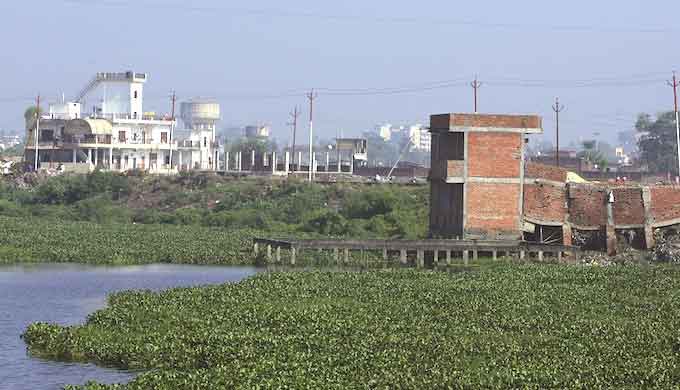
Peri-urban areas have suffered much neglect and harm in recent years, but a change of policy and priorities can still bring to them very creative livelihoods based on valuable but neglected traditional skills which can be utilized in important endeavors of increasing greenery, water-conservation and agro-ecology.
Peri-urban areas are semi-rural, semi-urban areas, or rural areas undergoing urbanization in the hinterland or fringe of cities. Even when they are included formally in city areas ( which may not always be the case), they suffer from neglect and cannot generally access the same resources as the city proper for various development needs.
Despite this these areas may often experience very rapid population increase as those people who seek livelihood in big cities but cannot afford the housing of the main city tend to live in peri-urban areas on rent, with a dream of ultimately having their own house here. In addition polluting industries which are increasingly not allowed in the main city are often set up here, and the workers employed in these industries also live here.
Original people of urbanizing villages include landowner farmers as well as former farmers who have sold their land, and also the landless sections. In addition peri-urban areas are likely to include a lot of migrant workers, including those who have now settled more firmly in their new abode and have only weak links with their original village. Migrants from minority communities are more vulnerable.
The main city needs spaces for disposing off its waste products, or for manufacturing products which involve polluting processes. The nearest visible source for this appears to be in peri-urban areas. Hence often landfill sites and polluting industries are located in peri-urban areas. The main city also needs sanitation workers, domestic workers, construction workers, guards, watchmen and other workers at a low cost on daily basis. A significant share of these often come from peri-urban areas. The main city needs construction materials. So if the peri-urban area has quarries of stone or sand deposits these will be exploited, or else brick-kilns may be set up here.
When slums are seen to be increasing in main city, the people living here may be evicted and sent to peri-urban areas. Hence the main city generally uses peri-urban areas in selfish ways to meet its needs, having a very narrow approach towards peri- urban areas. The only exception is when certain pockets of peri-urban areas get selected for housing or entertainment of the elite (picnic spots, banquet halls, farm houses), when such pockets get beautification drives or better investments, private and public.
However often this narrow selfish approach proves to be counter-productive for people of main city too. Peri-urban areas are the nearest possible source for daily supply of fresh vegetables and milk, but as pollution including water pollution increases in peri-urban areas the quality of these products suffers and there are health risks. By banishing polluting industries to peri-urban areas the elites forget that the ill impacts of pollutions and hazards can easily travel the few miles from peri-urban areas to reach the people of the main city as well.
On the other hand if social neglect leads to creation of crime dens in peri-urban areas, then the main city can hardly remain protected from the escalating crime that results.
If water-bodies in peri-urban areas are encroached and destroyed, then water supply for the main city is also depleted.
There is urgent need to recognize the many-sided potential of peri-urban areas. Instead of allowing builders and property dealers to decide the fate of peri-urban areas, these should be well-planned on environmental grounds with large green zones left for organic farming, orchards, groves, gardens and pastures. Existing water-bodies should be well-protected and water-harvesting should be linked to the creation of more lakes and tanks as well. Livelihoods of farmers and pastorals for supplying healthy vegetables, fruits, milk and milk products as well as other processed foods such as biscuits and other bakery products should be nurtured and promoted in various ways.
With more open spaces still available peri- urban areas are ideal spaces for establishing highly creative models of decentralized sanitation and waste-management, in the process also making available plenty of compost and manure for organic farming.
Rights of workers including those of unorganized sector workers and women workers should be well protected. The relatively poorer sections should not be confined should just to working for others but in addition opportunity for work as small-scale entrepreneurs should be encouraged, both to men and women, more particularly to groups such as self-help groups of women.
Social reform efforts to end all discrimination, to promote rights and opportunities for women , to establish communal harmony, to minimize consumption of intoxicants, to promote traditional crafts and folk arts and to organize community events should be promoted.
Bharat Dogra is a journalist and author. His recent books include Man Over Machine and Protecting Earth for Children.
GET COUNTERCURRENTS DAILY NEWSLETTER STRAIGHT TO YOUR INBOX









































